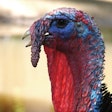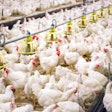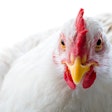
So far this year, Lesotho has become the ninth African state to report highly pathogenic avian influenza (HPAI) in poultry. For the country surrounded by South Africa, it also represents the first occurrence of HPAI.
The first outbreak to be officially registered with the World Organisation for Animal Health (OIE) was at a farm in the western district of Maseru. The presence of an H5 HPAI virus was confirmed after more than 800 of the 3,000 birds on the farm died in late May. The rest of the flock has been destroyed. The source of infection was attributed to the introduction of new birds at the premises.
In the past few days, an earlier outbreak has been recorded in the north of Lesotho. From May 22, around 2,500 laying hens died at a farm in the Leribe district, around 100 kilometers from the other outbreak. So far, 2,800 of the birds there have been culled. Introduction of 2,880 pullets at point-of-lay are thought to be the source of the virus.
Mali registers further HPAI outbreak
A second outbreak linked to the H5N1 HPAI virus variant has been officially registered in this West African state.
According to the latest OIE report, a second laying flock in Marakoforo in the Koulikoro region tested positive for this virus after around 30,000 of the 38,600 birds died at the end of April.
The report states that officials have begun to survey farms in the area between the affected region — which is in the southwest of Mali and borders Mauritania — and the capital city, Bamako.
With the first outbreak starting on April 9, the current HPAI outbreak “series” in Mali followed directly after another. Representing the first occurrence of the H5N1 HPAI virus in the country, the previous wave covered the period March 13-23 this year. It involved a total of 50,150 poultry located at two farms — one in Koulikoro and one in neighboring Sikasso — as well as a backyard flock in the Bamako city region.
Latest South African HPAI cases affect three provinces
In March of this year, the South African veterinary authority registered with the OIE first 10 outbreaks of HPAI. These were centered on the province of Gauteng. Cause of the outbreak was initially identified as a virus of the H5 group. Subsequently, it has emerged as an H5N1 virus.
After a hiatus during April, further cases have now been confirmed. In the period May 6-23 were the 10 latest outbreaks that directly impacted just over 800,000 poultry. Affected were six farms and a backyard flock in Western Cape, two premises in Gauteng (one small farm and a backyard flock), and a first location in KwaZulu-Natal.
Otherwise in this series now comprising 20 outbreaks, 10 have occurred in Gauteng, and nine in Western Cape (mainly around Cape Town). Of the around 837,600 birds directly affected, more than 22,400 have died, and almost 76,000 have been destroyed.
Situation may be easing in South Africa’s other bird flu waves
Between June of 2017 and November of 2020, South Africa was also battling to control an HPAI epidemic linked to the H5N8 virus variant. Starting in a broiler breeder flock in Mpumalanga, the infection spread to other provinces. The most recent confirmed cases were in a commercial ostrich flock in Western Cape at the end of last year.
Last but not least, a low-pathogenic avian influenza (LPAI) virus of the H5N2 subtype was detected at an ostrich farm in Western Cape in March, according to a recent official report to the OIE. Nine of the 682 birds tested positive for this virus. None died or was culled.
The only other cases in this outbreak series were at another ostrich farm in the same district of Western Cape in August of 2020.
Avian flu: another challenge for South Africa’s troubled poultry industry
Already in struggling from cheap imports and the effects of the coronavirus (COVID-19) pandemic, South Africa is now facing a series of avian flu outbreaks.
The poultry sector is preparing for a developing wave in the disease that could be as disastrous as the one in 2017, reports Business Live. That cost an estimated two billion rand (ZAR; US$148 million). Adding to the industry’s current challenges are rising feed costs.
The avian flu crisis in South Africa is forecast to peak in around three months’ time, according to this source.
Avian flu situation elsewhere in Africa
H5N1, H5N8, and H5N6 subtypes of the HPAI virus with pandemic potential in countries have been detected in Sub-Saharan Africa since February of 2017, according to the United Nations’ Food and Agriculture Organization (FAO).
As well as Mali and South Africa, the H5N1 variant has been reported in Burkina Faso, Cameroon, Côte d’Ivoire (Ivory Coast), Ghana, Mauritania, Niger, Nigeria, Senegal, and Togo. Nigeria has detected the H5N6 virus, while the H5N8 variant has occurred in Cameroon, Democratic Republic of the Congo, Namibia, Niger, Nigeria, South Africa, Uganda, and Zimbabwe.
Israel reports HPAI in wild birds 'resolved'
Between October of 2020 and April this year, Israel’s animal health agency registered with the OIE a total of 48 cases of the H5N8 HPAI virus in wild birds. The virus was detected in 17 different species — including in 36 swans — at eight locations across the country.
Source of the infection is strongly suspected to be migrating birds, as the cases coincided with the peak movements of wild species. The most recent case was a stork that was found sick in Hadarom in early April, and subsequently died. At the time, the migration was in progress over the country of birds from Africa to Europe.
South Korea continues elevated egg imports
According to a recent report from the ministry of agriculture in South Korea, egg imports are set to continue for at least one more month.
At a meeting last week, the ministry resolved to raise the import quota to 50 million eggs. The move followed import authorization of 40 million eggs in each of the preceding two months.
Earlier outbreaks of HPAI in South Korea that hit hard the country’s laying flocks have been blamed for a shortage in domestic production and food price inflation in South Korea.
Based on data supplied to the OIE, the latest HPAI wave in South Korea has involved a total of almost 10.26 million poultry, comprising 22,000 mortalities and 10.24 million more culls.
Since the latest wave of HPAI hit the country in November of last year, 109 outbreaks of the disease have been confirmed in the country. However, two months have elapsed since the last cases in poultry or wild species, and migratory birds have returned to their summer territories. As a result, the HPAI alert level has been reduced to the lowest category.
Last week, China reported what is thought to be the world’s first human infection with H10N3 influenza virus of avian origin. It is reported that the patient — a man in his 40s — has recovered. According to Chinese experts, this virus poses a “very low” risk of causing a large outbreak.
View our continuing coverage of the global avian influenza situation.














